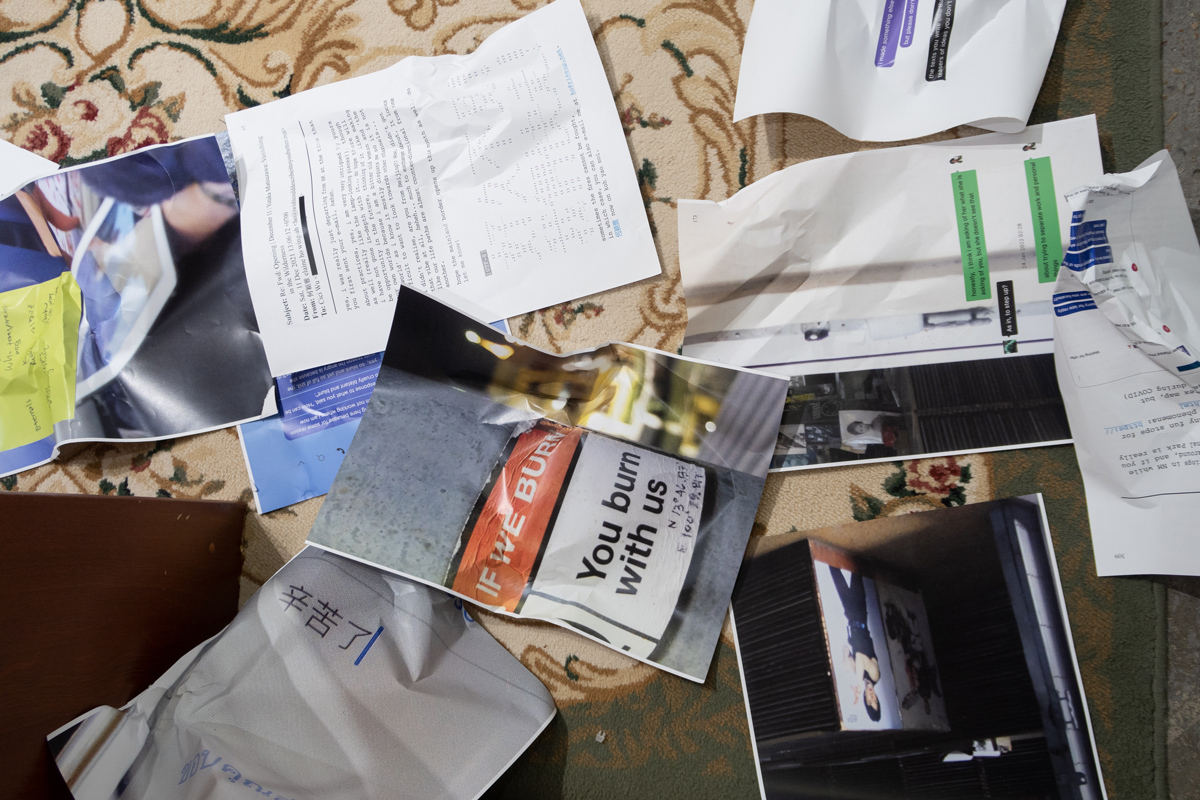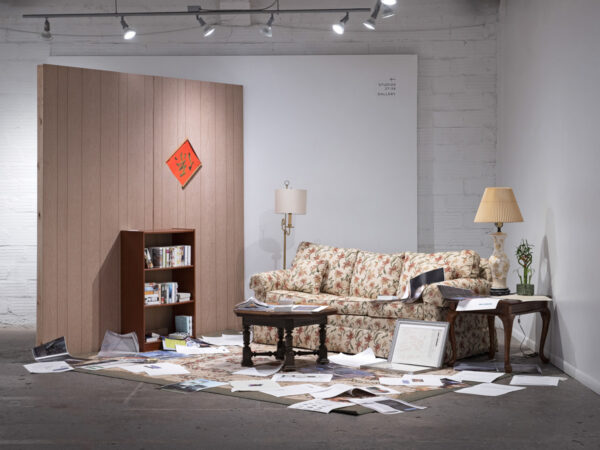Middle sis’ insane pub zook Resident Evil available for acquisition from the Display Distribute distro: https://displaydistribute.com/mukluk/resident-evil/
Thank you 點 to Max Fields for the commission and very generous curatorial text for this contribution to the 2022 FotoFest Biennale, If I Had a Hammer:
Artist-researcher Elaine W. Ho’s multifaceted practice encompasses visual art, design, music,
distribution and logistics, commercial sales, community organizing, film and video production, curation, writing, and publishing. The thread that binds Ho’s seemingly disparate projects together is her engagement with networked forms of communication and collaboration as a way of examining and exposing the structural processes that underpin various modes and forms of production. In her own words, “multiplicity is not something new to me, and in fact something I could call a purposeful experimentation—to play with the boundaries of collaboration and labor in a manner that questions a very fundamental sociopolitics of being.” 1 Ho’s probing of diverse boundaries is always positioned within the scope of the systems of relation that connect art, economics, and politics. Her work asks us to consider the many ways in which the precariat’s labor (mental, physical, material, and otherwise) upholds power structures, while offering examples of how to interrupt, intervene, and shape systems in order to serve those disproportionally affected by systemic hegemony.Ho’s expansive methodologies are expressed in her presentation for If I Had a Hammer through an installation that centers on a 400-plus page book, published under the artist’s prolific imprint Display Distribute, which she co-runs with founder Ming Lin. Titled Resident, or Resident Evil, or This Minor Contextualisation of a Particular Temporality Known as Publishing on the Run, Ho’s book and subsequent multimedia installation are reflections of the artist’s experiences, both professional and personal, over the course of winter 2021 and summer 2022. Resident is presented as a document, or perhaps more accurately, a detailed record of the artist’s input and output, and includes excerpts from influential essays, emails and chat logs, scanned letters, invoices, travel bookings, and images of friends, projects, memes, and uncredited snapshots captured and shared with the artist online and over social media. It is, as the artist has stated in email interviews, a portrait of precarity in pandemic time, as well as a deeply personal, transparent reflection of a life mediated by screens, platform corporations, and impending budgets and deadlines.
The Evil referenced in Ho’s book and installation represents, to a degree, the varying apparatuses that lurk within the various systems that benefit from either forging or disjoining specific social connections. “Evil” in Ho’s context is synonymous with power, the devices of
which can be co-opted by the emboldened producer whose goals are to exploit that which
exploits others. We see this co-opting happening throughout the pages of the artist’s book as
she works to remedy oppressive and limiting global trade issues directly through her LIGHT
LOGISTICS logs: a diary in spreadsheet and email-chain form that chronicles the artist
coordinating shipments of Display Distribute materials through a network of volunteer couriers who sign up to drop off goods while traveling around the globe for personal and work-related reasons. We also see the artist’s constant shifting of self-imposed responsibilities, wherein the collective is almost always privileged over the capitalistic death-drive: to deliver quickly, efficiently, and without complexity in order to maximize profit. And yet, as indicated by the labor-related listicle that introduces this text, the artist has taken on the role of the director of multiple operations. This though is not the result of courting capitalist desire, but rather the direct consequence of the contemporary capitalist ecology, wherein individuals must support themselves by becoming multi-hyphenate workers.The installation presented in the exhibition is composed of a series of home goods presented together in the form of a staged living room. The aesthetics of Ho’s in-gallery home echoes
1980s–90s domestic decor. We find a rug, a sofa, wood paneling on the walls, images strewn
everywhere, a lucky bamboo plant, and calligraphy scroll–design elements familiar to those
who grew up in Asian American homes. In an interview with the artist, she describes this staged setting as a catalyst for unpacking complex narratives that defy straightforward temporal boundaries. Specifically, Ho discussed her domestic history, wherein her mother, a first-generation Chinese immigrant, worked as a “middleman” in the food industry. “My mother didn’t produce anything. She moved stuff. But the middleman, the agent, the hacker, and the smuggler are all highly efficacious roles to grease or intervene in these mostly invisible
infrastructures, and that is exactly what fuels much of my inquiry.” 2 The labeling of her mother as a hacker working within capitalist structures while exploiting its conditions sheds light on the domestic staging in the gallery. The installation is not only marking a specific moment in time by dating the decor, but also connecting the aesthetics of then to the contemporary now within which the work is being presented; it’s a method of conflating her family’s history of co-option and subversive behavior.The imagery within Ho’s Resident installation is typical of that which is seen on social media.
Screenshots and snapshots, often cropped to frame information, transforming the banal and
ordinary into poetic visual verses. Imagery is also referenced in the artist’s title through her
appropriation of the phrase Resident Evil, which references a popular video game and film
franchise that follows the story of a post-apocalyptic world overrun by zombie hoards created
by a private military corporation. Applying double meaning to the phrase “resident evil” in the
context of Ho’s work, wherein images and text cover the staged domestic space, we can
imagine ourselves as the “resident” zombie, generating and exercising “evil” (power) to
deconstruct and reimagine the capitalist systems that create and maintain the conditions of our being. This apocalyptic referent is presented at FotoFest in the crisis-laden present, wherein the signs of apocalypse appear each morning through daily headlines. In his book, Combined and Uneven Apocalypse, Evan Calder Williams describes the conditions that a zombie apocalypse produces, writing:
Out of an apocalypse comes the hard work of the post-apocalyptic. […] What ‘comes back’ in the apocalypse isn’t necessarily—or ever—a happy unity of broader inclusion. Apocalypse is the coming-apart of the rules of the game, and in the ruined wake of this, the task isn’t one of rebuilding, of mourning, or of moving on. It can only be […] the ceaseless struggle to dismantle and repurpose, to witness the uncanny persistence of old modes of life, and to redraw the maps and battle lines of the sites we occupy. In other words, we do not become post-apocalyptic because the plague swells, the bomb drops, or the earth cools. We become post-apocalyptic when we accept the present as rubbish, as undead, and as under attack. And when we refuse this acceptance, to salvage the scraps of antagonistic history that we inherit, to articulate militant reason out of the obscene persistence of what refuses to die, and to make the apocalyptic not a temporal event but a spatial organization. To be post-apocalyptic is to make of a given condition a decision and a commitment.3


